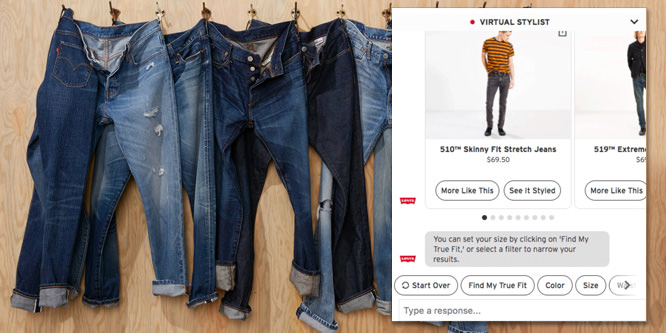
September 7, 2017
Will Levi’s virtual stylist put more online shoppers into its jeans?
Anyone who has shopped for Levi’s jeans lately knows that the brand offers an ever-expanding selection of variations on the basic theme of denim. To help e-commerce customers navigate the options, Levi’s has rolled out its own virtual stylist.
Levi’s virtual stylist is accessible both through the levi.com website and through a Facebook Messenger chatbot, according to a press release. Users can chat with the bot in a conversational tone to get advice about which variety of jeans will meet their needs. The bot asks questions about fit, shape and stretch preference and combines the responses with sizing information to give a recommendation. The virtual stylist also allows users to share potential jean styles they’re considering and let their friends vote on them, and offers a gallery of user-generated images of people wearing each product.
The virtual stylist represents another major brand making use of a chatbot that can communicate with customers to walk through the ordering process and help in product selection. Subway, for instance, has implemented a Facebook Messenger bot for sandwich ordering. In apparel, The North Face offers a conversational Watson-based AI to guide website customers to a piece of clothing that meets their needs.
Using a chatbot to give customers a clearer idea of what jeans will look like in real life could help Levi’s reduce e-commerce returns, a money-saving goal that many apparel e-tailers are striving for.
Third-parties have jumped in to try to solve the high-returns problem. Mobile app Metail, for instance, allows e-commerce customers to see how clothing with fit on virtual on-screen bodies.
But Levi’s virtual assistant could be more effective than apps like Metail if only because of the nature of the product. While a virtual try-on for a broad range of apparel may not quite stand in for the real try-on experience, Levi’s jeans have a finite number of characteristics — and e-commerce shoppers may stick with a variety they like.
Discussion Questions
DISCUSSION QUESTIONS: Is the virtual stylist something Levi’s shoppers need and will they use it to choose jeans? What makes a brand a good candidate for leveraging an online assistant/chatbot and similar technology?
Poll
BrainTrust
Brandon Rael
Strategy & Operations Transformation Leader
Ryan Mathews
Founder, CEO, Black Monk Consulting
Recent Discussions







Ultimately a virtual stylist could prove to be very effective for Levi’s higher-priced categories, as well as the customization sector. Other digital native e-commerce companies, such as Bonobos, Warby Parker and Shoes of Prey depend on a virtual digital platform, as most of their products enter into the customization categories. This curated online experience has worked extremely well, especially when it translates over to a curated in-store/showroom-like experience as well.
Levi’s is certainly taking the right steps to integrate their commerce platform with social channels. Chatbots are becoming omnipresent and, with the power of AI, are continuously learning and improving.
I guess I’ve always thought of Levi’s as being a staid, rugged brand. Where a person knows their cut, waist and length but may vary on color and fabric. This does not sound to me like a brand that needs a “stylist.” Is this the best way to add value and ease to the customer’s journey? I’m not so sure. So let’s just say, I’ll be interested to see how many opt to use it. For my 2 cents.
An excellent move by Levi’s! It may not always provide the perfect pair of jeans but it will sure serve to engage customers with the brand, increase chances of good fit and possibly attract new customers. Buying jeans can be an unpleasant experience for some people and body shapes and this might just help to ease the process!
The real opportunity here might be to sell customized clothing. For example, Levi inseams come in two-inch increments. If you have, say, a 29, 31 or 33 inseam you are forced to buy “up or down” — in this case a 28, 30 or 32 inseam or a 30, 32 or 34. The only other option is to buy long and roll the cuff. Obviously there is no way Levi’s or any other mass brander could stock stores with every available size combination, but why not let a customer order her or his exact size online?
My bet would be that people would happily pay a surcharge for jeans that actually fit. I guess the other issue might be to ask if Levi’s has too many style options, making it hard for shoppers to “find” the right style for them in the first place. Carhart, for example, offers far fewer options but seems to be doing a fairly healthy business, even among hipsters.
When shopping online, or with a brand for the first time, it can be difficult to know which product best suits your needs. Especially with a brand like Levi’s which specializes in a certain product range, denim, but has a lot of options. I think the virtual stylist is a great way to help guide online customers through the buying process, much like an in-store assistant would. If people feel confident in what they’re buying then it might convert a few more online sales as well.
When it comes to an individual customer’s fit, look and feel preferences, the multitude of sensory outcomes of even the most “finite characteristics” combined in a 3 dimensional garment create vastly different sensory fit, look and feel outcomes, impossible for a bot to translate.
The top 2 reasons: 1) The complete and utter subjectivity of words to both the speaker and the receiver of the words. The bot’s “loose fit” may be the shopper’s “baggy fit.” 2) The complete subjectivity of individual human fit, look and feel preferences.
A bot is a middleman, reacting subjectively to the way it was programmed to respond to each input by the shopper. Inbred bias. Seeing how a garment “fits” you on a virtual person is a linear representation of a 3 dimensional reality. Friends may say “you look great” in the virtual representation of you, which is not the same as you loving the fit, look and feel of your new jeans.
The end game — preference match the sensory profile of a product to a person through the filter of individual human preference.
A friend in the fashion industry told me 10 years ago that I was wearing the wrong cut of jeans. That advice changed my shopping habits permanently, for the better. If a virtual stylist can have the same impact on shoppers, all the better. Denim today has so many variations that it can often be overwhelming. This is great use of focusing on the consumer and what they need to improve the experience. The breadth of Levi’s catalog seems a great fit for this type of technology.
I think most shoppers don’t realize how many variations in style there can be with jeans and other denim products. Levi’s wants to grow their share of closet with their customers. Anything that helps their customers identify more options to buy can only help their sales bottom line. This is a great idea by Levi’s to leverage chatbot technology! Brands that have a narrow product focus, yet create many variations and therefore difficult decisions on choice stand to benefit from virtual assistants like this. On the other end of the spectrum, a brand with many products and many options within them would also benefit.
While customers love choice, offering too much choice only makes the decision process more complicated. Complexity leads to giving up and not making a purchase quite often — leveraging a virtual assistant to make this process easier is akin to having an expert store associate help you make a selection. That’s something all shoppers like to experience.
The virtual stylist is definitely something Levi’s shoppers can use to choose jeans and it will also provide a more customer oriented shopping experience. While repurchasing your go-to jeans is easy to do online, purchasing a new style, fit, or model can be a bit harder. Some shoppers may not want to purchase new products online with the fear it won’t fit properly and they’ll have to return it. Not only is the virtual stylist a great way to attract new customers, but also a great way to sell more and different types of jeans to existing customers.
Jeans, beauty, bathing suits and undergarments — ANYTHING that retailers can do to help us ladies with those 4 and we’re saying thank you. Doesn’t have to be perfect — just thank you for thinking of us and trying. 🙂
This is about a customer engagement play. How can we get a customer to interact with the retailer on their website? Done well, the retailer gives the customer a great experience, engaging them with activity that will get them to come back. The virtual stylist to Levi’s shoppers is akin to a virtual makeup artist to the online cosmetic companies. There is a segment of customers that love this type of interaction.
While not every retailer can use a virtual stylist, just about any retailer can take advantage of an online assistant or chatbot.
I can’t see the virtual stylist in work, it isn’t available for Australia yet, but I think idea is great. Everything that helps a customer to make a right choice (a) increases the sales (b) reduces the number of returns.
So if executed correctly it is a right step.
Probably having a real 3D fitting based on actual use measurement will be even better, but it may be the next step.
Any time that you can remove the fear of not having a product in your hand and create FOMO (fear of missing out) it’s a good thing. All sorts of industries can make this work for them — particularly products that require context. Furniture, apparel and glasses are all categories where some sort of virtual rendering has already started.
Sephora has started down this path too — we’ll see how much the cosmetics consumer likes a virtual assistant, but by all accounts it’s going well.
More importantly, having a virtual assistant allows you to test and learn even more about your consumer. This allows you to clearly map decision making moments and key moments that make your consumer walk away, or commit to purchase.
As the technology improves, virtual stylists will work well for Levi’s as well as other clothing and fashion brands, not only in reducing the rate of ecommerce returns, but also in engaging consumers in a more personalized manner. Advanced AI is reaching a tipping point, where virtual shopping tools can deliver a customer experience that is as good as the in-store shopping trip. The real advantage to Levi’s and other brands using these tools, beyond being able to more accurately guide the customer into a product that fits well, is the opportunity to better understand those customers on a much deeper level. There is a tremendous opportunity here to use these shopping bots to learn more about customers at a very granular level, and to use that intelligence to create greater customer loyalty.